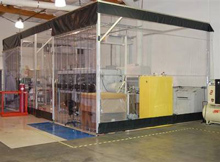Battery fab: This enclosure houses automated equipment for building and testing hundreds of batteries a week. Each battery is made from different experimental materials. Credit: Wildcat Discovery Technologies
Wildcat has developed a pair of new materials that set new standards for the rechargeable battery industry, by providing unprecedented energy density of more than 675 Wh/kg while operating in full cells at 5 volts – levels beyond today’s industry standards.
Wildcat’s EM1, a novel 5V electrolyte formulation, and CM1, a new high voltage cathode material, have been shown to deliver a 25 percent improvement in gravimetric energy density, and a 61 percent improvement in volumetric energy density in the electrode, compared with existing state-of-the-art battery materials with comparable attributes. Thus far, batteries made with EM1 and CM1 have expected power and safety performance comparable to lithium iron phosphate (LiFePO4), while also handling more than 100 charge/discharge cycles in full-cell testing.
“This is a breakthrough discovery by our development team, which can lead to batteries capable of storing much more energy than current materials allow,” said Wildcat CEO Mark Gresser. “When batteries hold more energy, it creates new options for design engineers – electric cars can go farther, tablets, laptops and smartphones can be smaller with no loss of runtime, soldier packs can be lighter, and implanted medical devices can last longer before the need for replacement surgery. And while our initial tests have shown a 61 percent improvement in energy density, this is just the beginning – because the EM1 electrolyte is stable at 5-volt operation, it opens the door to development of a new world of cathode materials that should bring even greater advances.”
Gresser added that the new materials are fully compatible with industry-standard anode materials.
The EM1 electrolyte’s high-voltage capability is of special interest for the automotive sector, where cell development has been restricted by the inability of existing electrolyte formulas to cycle at high voltages. Current EV systems based on low voltage cells require complex and expensive pack designs and battery management systems. EM1 enables high voltage systems which are expected to reduce required cell quantities 30-40% vs. competing materials like LFP and NMC. Fewer cells and simpler pack designs translate into substantially lower costs for auto makers.
The materials were developed using Wildcat’s proprietary high-throughput synthesis and screening platforms, which enable rapid discovery and development of advanced materials. For the CM1 cathode material alone, Wildcat’s R&D team synthesized and evaluated more than 3000 materials in just eight months; this research may have taken years using conventional methods.
In addition to battery materials, Wildcat can tailor its proprietary discovery tools to work with other platforms of interest. Select from the links above to learn more about the following platforms:
* Lithium-ion Batteries
* Hydrogen Storage
* Industrial Gas Separation
* Carbon Capture
* Electronic Inks
If you liked this article, please give it a quick review on ycombinator or StumbleUpon. Thanks

Brian Wang is a Futurist Thought Leader and a popular Science blogger with 1 million readers per month. His blog Nextbigfuture.com is ranked #1 Science News Blog. It covers many disruptive technology and trends including Space, Robotics, Artificial Intelligence, Medicine, Anti-aging Biotechnology, and Nanotechnology.
Known for identifying cutting edge technologies, he is currently a Co-Founder of a startup and fundraiser for high potential early-stage companies. He is the Head of Research for Allocations for deep technology investments and an Angel Investor at Space Angels.
A frequent speaker at corporations, he has been a TEDx speaker, a Singularity University speaker and guest at numerous interviews for radio and podcasts. He is open to public speaking and advising engagements.


